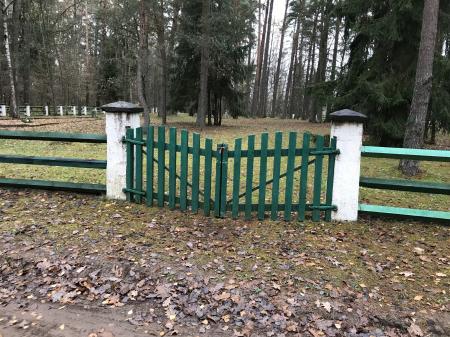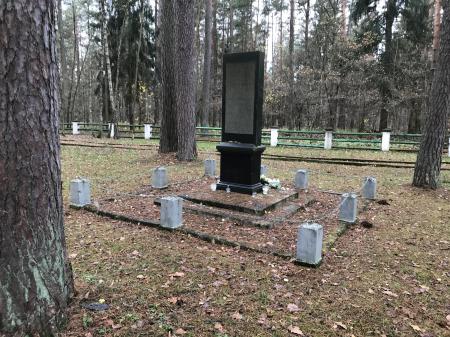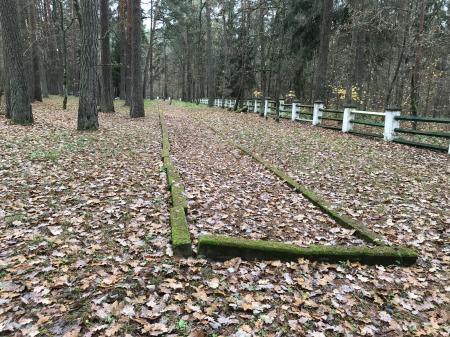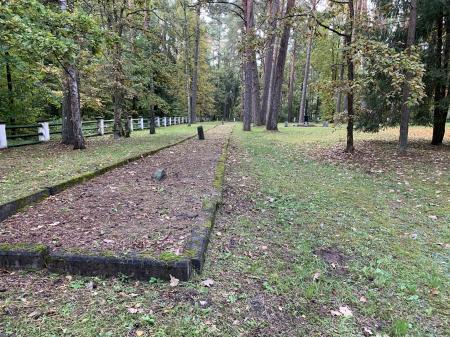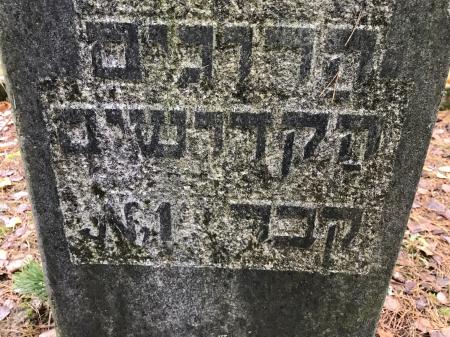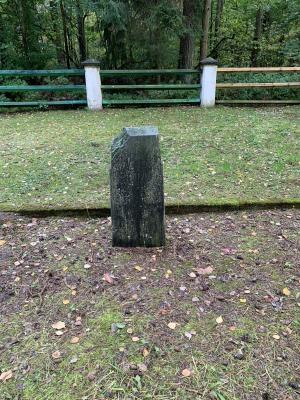Obj. ID: 52875
Jewish Funerary Art Holocaust memorial in Biliūnai near Panevėžys, Lithuania, 1948

Memorial Name
Who is Commemorated?
7,523 Jews of Krekenava, Panevėžys, Piniava, Raguva, Ramygala, Troškūnai and other rural districts murdered at this site.
Description:
The monument is situated at the killing site, which is fenced by a fence made of concrete posts and wooden rods.
There are four mass graves (killing pits) marked by concrete curds and granite inscribed steles: Grave 1 on the left-hand side, Grave 2 on the right-hand side, and Grave 4 near Grave 2. It seems that Grave 3 is marked by the central monument and it is situated near Grave 1 (it also could be that the signs for Grave 3 have disappeared with time).
The central monument is a high black marble stele, which is probably a reused gravestone from one of the Jewish cemeteries. This hypothesis is supported by the fact that there was an inscription on its backside which was later completely raised. The stele stands on a concrete base. Its front side contains an inscription in Yiddish mixed with Hebrew and a significantly different Russian inscription beneath it. A Star of David with the abbreviation פ"נ appears in the middle of the first row. A Lithuanian inscription on the pedestal of the stele might be the signature of a stonemason who produced this stele, probably in the early 20th century. The monument is surrounded by 9 concrete posts and metal chains between them.
Grave 1 is marked by three signs: a granite stele with a Hebrew inscription and a Star of David; a granite stele without an inscription, and a small granite round stone.
Grave 2 is marked by two signs: a granite stele with a Hebrew inscription and a Star of David; a small stone cross probably added recently.
Grave 4 is marked only by a granite stele with a Hebrew inscription and a Star of David.
In the early 1990s, the Jewish community of Lithuania added a stele with a Lithuanian inscription. It stands on the left-hand side, between the site's fence and Grave 1:
Inscriptions:
The main monument:
Yiddish and Hebrew:
פ"נ הַרוגים הַקדושים
די פיר מאסן-קבׇרים
פוּן די ייִדן פוּן פּאנעוועזש
און אומגעגנט וואָס זייַנענ [זיינען]
דערמאָרדעט געוואָרן
פוּן די דייַטש-ליטווישע
פאשיסטן אין אווגוסט 1941
Translation: Here are buried killed martyrs. / The four mass graves / of the Jews from Panevezh / and vicinity that were / murdered / by German-Lithuanian / fascists in August 1941.
Russian:
Братская могила
евреев Паневжиса [Паневежиса]
и окрестностей
зверски замученных
фашистскими
бандитами
1941 г. в августе
Panevėžys Elertas
Translation: The mass grave / of the Jews of Panevėžys / brutally murdered / by fascist bandits / in August 1941
Lithuanian, on the pedestal:
Panevėžys elertas
Grave 1:
Hebrew:
פ"נ
הַרוגים
הַקדושים
קבר 1 №
Translation: Here are buried killed martyrs. Grave № 1.
Grave 2:
Hebrew:
פ"נ
הַרוגים
הַקדושים
קבר 2 №
Translation: Here are buried killed martyrs. Grave № 2.
Grave 4:
Hebrew:
פ"נ
הַרוגים
הַקדושים
קבר 4 №
Translation: Here are buried killed martyrs. Grave № 4.
Commissioned by
Jewish survivors from Panevėžys 1948
sub-set tree:
The murder of the Jews of Panevėžys took place on August 23, 1941. Two pits about 40 meters long were dug in the forest. Jews were brought to the shooting place by troops of the Panevėžys (10th) battalion. The massacre took all day. A total of 7,523 Jews were shot (1,312 men, 4,602 women, 1,609 children). Jews from different rural districts of Panevėžys district were murdered along with the prisoners of the Panevėžys ghetto.
A monument on the killing site with Yiddish/Hebrew and Russian inscriptions was installed in 1948 by the Jewish survivors from Panevėžys. Apparently, the site was fenced, in the 1950s.
In the early 1990s, an additional monument with a Lithuanian inscription was erected.
On February 18, 1993, the monument was registered in the State Cultural Register of the Republic of Lithuania as a site of national importance (no. 11058).
Jakulytė-Vasil, Milda. Lithuanian Holocaust Atlas (Vilnius: VIlna Gaon State Jewish Museum, 2011), p. 139.
Kultūros vertybių registras, https://kvr.kpd.lt/#/heritage-detail/63e8cc41-cf5f-4a3e-92f6-95c05971fa10., https://kvr.kpd.lt/#/ (accessed April 24, 2022)



